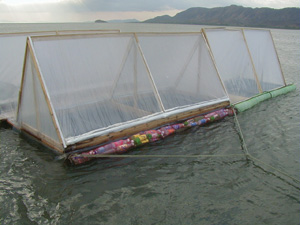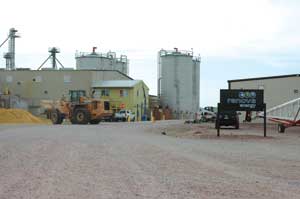September 2008
 View Full Print Edition
View Full Print EditionBusiness Briefs
Columns

Food for Thought
By Robert Vierhout
Construction Continues at a Steady Pace
By Craig A. Johnson

Financial Restructuring Alternatives for Bioenergy Companies
By James Lodoen and George Singer

Americans See Through the Blame Game
By Bob Dinneen

Bioenergy Takes Emphasis over Biofuel
By Mike Bryan

Disaster Aftermath Preparedness
By Rona Johnson

Building Sustainable Communities
By Art Wiselogel

Proposed Plant List Doesn't Tell Whole Story
By Jessica Sobolik

ASTM Blend Specifications: What Do They Mean?
By Stu Porter
Featured

Food, Fuel and Politics
By Anna Austin
The Food before Fuel campaign—designed to convince the public that biofuels are responsible for rising food costs and to press the government to rein in its renewable fuels' mandate—has caused a lot of heartburn. The question is whether consumers believe that the companies supporting this campaign are looking out for their best interests.

Rocky Mountain E85
By Timothy Charles Holmseth
From a good idea, to a better idea, to a comprehensive governor's coalition, the state of Colorado has invested in an ethanol economy that's a long way from the Corn Belt, but motorists, business owners and foreign countries are taking note of Rocky Mountain E85.

Overcoming E20's Obstacles
By Kris Bevill
As E10 has gained acceptance as a standard fuel in the United States, efforts are moving ahead to increase the amount of ethanol to 20 percent. Several studies have tested the effects of midlevel ethanol blends on vehicles, but more work remains to convince naysayers that midlevel blends are efficient, environmentally friendly and safe to use.

Good Neighbors
By Story and Photos By Susanne Retka Schill
Residents of Watertown, S.D., are basking in the benefits that have accompanied the building of an ethanol plant on the edge of town. From lower utility bills for city residents to plentiful feed for surrounding dairy farmers and cattle feeders, Glacial Lakes Energy LLC has had a positive impact on the community.

Beginning of the Blender Pumps
By Erin Voegele / Photos by Susanne Retka Schill
A grassroots biofuel revolution that's been brewing in South Dakota for years is on the verge of sweeping the country. Ethanol blender pumps, considered by many as a means to increase the demand for ethanol while reducing America's dependence on foreign oil and mitigating high gasoline prices, are popping up in various Midwest locations.

Challenge X: The Last Lap
By Bryan Sims / Photos By Roy Feldman
The Challenge X: Crossover to Sustainable Mobility competition completed its fourth and final year in May. EPM talked with some of the teams who used E85 to gauge their opinions about using the renewable fuel.

Food and Fuel Technology Bundle
By Ron Kotrba
Two years ago, ICM Inc. began a project to integrate a 40 MMgy ethanol plant with an existing food-processing facility. The same engineering firm that standardized the dry-grind ethanol plant design now prepares to deploy its latest technology package—and dry fractionation is just the beginning.

Dealing With Disaster Debris
By Ron Kotrba
From hurricane winds and flooding, to radicals piloting passenger jets into skyscrapers, disasters are a tragic part of life. After people are safely removed from harm's way, proper planning and technology could be used to revolutionize debris management.
Furfural: Future Feedstock for Fuels and Chemicals
By Jessica Ebert
Furfural, a sister chemical to the increasingly popular hydroxymethylfurfural or HMF molecule, is regaining attention as a biobased alternative for the production of everything from antacids and fertilizers to plastics and paints.

Is Biomass Harvesting Sustainable?
By Jerry W. Kram
Sustainability is a buzzword in the biomass industry. But sustainable can mean many things. You can do your best by Mother Earth, but if you don't make money, your operation isn't sustainable. You can have the ability to make money hand-over-fist, but if you can't get the biomass to your plant, that's not sustainable either. A collaboration of researchers studied a biomass operation in the Superior National Forest in Minnesota to look at all the different components of a sustainable biomass harvesting operation.

Oceans of Biomass
By Anna Austin
From animal manure to crop residue, all options are being explored to reduce global dependency on fossil fuels. In response to this quest, one Costa Rican scientist poses a novel question: What about the ocean? Seaweed is primarily grown in the Eastern Hemisphere to produce fertilizer and food, but what potential do these plants and our oceans hold for biomass applications?

Biomass, Wind, Coal, Hydro, Petroleum ...
By Ron Kotrba, Jerry W. Kram, Bryan Sims, Anna Austin
The Energy & Environmental Research Center in Grand Forks, N.D., hosted the Biomass '08 Technical Workshop in July. Hundreds gathered from the United States and six countries to learn about the latest developments in the production of fuels, power and chemicals from biomass. The main message that came out of the conference was the need for strong partnerships and many different fuels.
2008 Proposed Biodiesel Plant List
By Craig A. Johnson, Timothy Charles Holmseth, Erin Vogele, Anna Austin, Suzanne H. Schmidt and Ryan C.
Biodiesel Magazine presents its annual roundup of proposed plants from across the United States and Canada. This year's list includes 26 plants somewhere between concept and construction. This number is lower than in past years, reiterating a slowdown in projected growth but also confirming continued interest in the industry's potential.

Paying a Premium
By Ron Kotrba
Oil prices of $140 a barrel will naturally apply significant upward pressure on all transportation fuels, but diesel prices have ballooned relative to gasoline in recent times. High global demand and slow-to-catch-up diesel refining capacity are largely to blame, so what's being done about it?

Proving the Collocation Concept
By Kris Bevill
Biodiesel producers are on the lookout for low-cost feedstocks and the means to process those feedstocks as the cost of soy oil remains out of reach for many operations. This isn't stopping a group in north-central Missouri, who may have a solution to tight profit margins. Producer's Choice Soy Energy plans to build and operate a soybean crushing facility next to a biodiesel plant.

Plantation-Scale Oil Production
By Susanne Retka Schill / Story & Photos
Some aspects of palm oil production parallel American soybean production practices, but many others reveal a radically different system.
Improving the Bottom Line On the Front End
By Jerry W. Kram
To avoid high-priced virgin vegetable oils, many in the industry are looking for alternatives. But inexpensive feedstocks are cheap for a reason-they carry high levels of undesirable components such as free fatty acids that make it difficult to produce biodiesel. Pretreatment systems, however, can clean up less than desirable feedstocks and improve producers' bottom lines.
Contributions

Measuring the Total Carbon Footprint of Biofuels Through Life-Cycle Analysis
By Kenneth J. Markowitz, Bernd G. Janzen and Emily C.
















